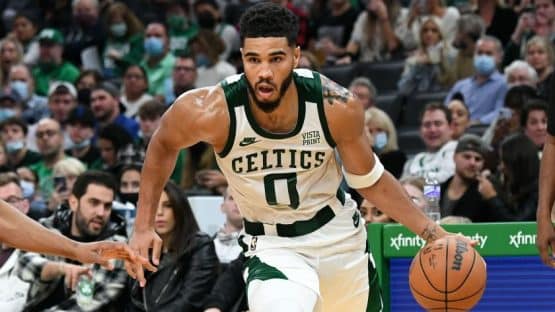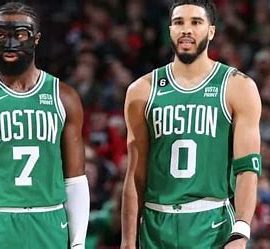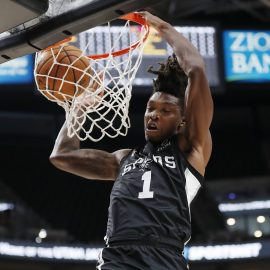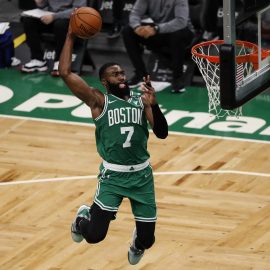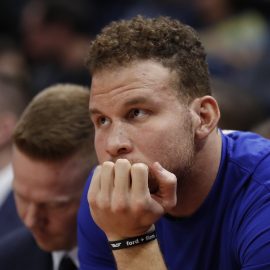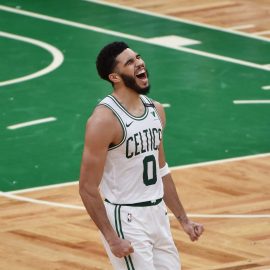Every morning, we compile the links of the day and dump them here… highlighting the big storyline. Because there’s nothing quite as satisfying as a good morning dump.
…but not for the Celtics. Their first game is tomorrow night against Milwaukee.
So let’s look at some season previews. Over at the Athletic, Jay King has ten things to watch this season:
I’m most interested in seeing how much of the Celtics offense bends toward Tatum. The Celtics lost one of their best playmakers in Gordon Hayward and won’t have Kemba Walker on the court for at least a little while. The coaching staff could at least be tempted to turn Tatum loose. Some of the best offenses orbit around one player. Tatum doesn’t have the playmaking chops of Luka Doncic or James Harden (hardly anybody does) but averaged five assists per game during the playoffs and should be expected to continue advancing that part of his game.
Every player in the league has a point of diminishing returns: There is a point past which it does not pay for them to have the ball. With Jayson Tatum still very much on an upward career trajectory, I don’t think we can look at his usage stats from any of the previous years and extrapolate a meaningful projection for how much Tatum is too much Tatum this season. But, as Jay points out in the article, it’s a good bet that we’ll find out in the early going, as the team adjusts to the absence of Hayward and Walker.
Brown averaged more turnovers than assists last season. He has never averaged more than 2.1 assists per game. He could need to lift that number, especially early in the season while the Celtics are shorthanded. More will be on Brown’s plate. He wants the extra responsibilities, but whether he can maintain his impressive efficiency — and lift up the players around him — remains to be seen.
Like Tatum, Brown is young and still working on his game. He has–rough start to the 2019 season notwithstanding–put forth the effort to improve his game every off-season. Jaylen has all of the ‘raw material’ required to be a better passer–and to turn the ball over less often–what he needs is coaching and practice reps to adjust his muscle memory. Practice reps are going to be in short supply in this truncated season, but I’m confident that we’ll see at least some improvement from Brown in this area.
Despite stretches when their zone offense looked powerful, Boston finished 24th in that category for combined regular season and playoff results, according to Synergy Sports. The Celtics ran into almost three times as much zone defense as anybody else in the postseason — and scored just 0.883 points during those situations. For reference, the Knicks, who had the worst halfcourt offense against man-to-man coverage during the regular season, still scored more effectively than Boston did against zones.
Boston’s poor play against zone defenses is a combination of poor recognition by the least experienced basketball team in the league and poor preparation by the coaching staff.
Gimmicks work because the NBA is not the NFL. In an average NFL game, there’s what? Maybe 22 minutes of actual football, the games are played only once per week, and you have an army of coaches parsing every second of available film. And then, once one team figures out how to react properly to a gimmick, their strategy ends up on film, where an army of coaches parse every element of it and adapt it to their team.
There’s a reason why zone defenses are not the preferred strategy for NBA ball: They don’t work very well once they’ve been identified. A motion offense will make quick work of a zone defense by stretching it out of shape and then exploiting the resultant holes.
The problem is that the zone defenses that Boston faced against both Toronto and Miami were sort of hybrid zone/man schemes, where the defense would show man-to-man coverage and then collapse into a zone once the Celtics committed to an offensive set that the zone was keyed to prevent. Without trying to split blame between players and coaches, it’s clear that both will need to do a better job.
At NBC Sports, Chris Forsberg has some “bold” predictions:
Consider this: While Walker was sidelined early in calendar year 2020 and Tatum made his leap, Tatum averaged 32.9 points per 40 minutes for the month of February. He might have to do the same to start the 2020-21 season just to keep Boston afloat.
I don’t know about this one. It’s undoubtedly early, but I feel like this Celtics team has more of a 60s’ vibe, where you’re going to have some great guys, but success is going to be very much a team effort. And with the combination of youth & injuries, I think the C’s are going to have a very rocky start to the season. So Tatum’s not going to be the best player on the team with the best record, nor–in my opinion–is he going to be a stat hog the way Westbrook and Harden have been.
Maybe this is just wishful thinking given the state of our pandemic world right now but let’s cross our fingers and hope that vaccine distribution helps fans get back inside TD Garden by June. The Celtics, after surging their way to a fourth-place finish in the East after a painfully slow start, draw the top-seeded Bucks in the East semifinals and ride the boost from a rollicking Garden to get back in the conference finals.
I could definitely see the C’s ending up with the fourth seed this season. It’s going to take a while for Boston to get up to speed, and I think both the front office and the coaching staff are prepared for a bit of a slog.
Fans in the seats, though?
Man, I don’t know about that. It doesn’t feel like six months will be long enough to evaluate (1) the long-term efficacy of the various COVID vaccines, especially since we have considerable evidence that some individuals can be reinfected within a fairly short time period after acquiring immunity by natural processes, and (2) whether immunized individuals can still spread the illness.
I’m more or less resigned to at least another year of masks and social distancing protocols.
Add The Sports Daily to your Google News Feed!
